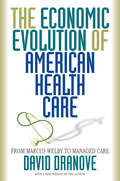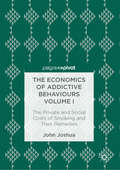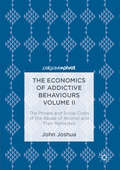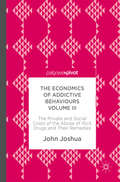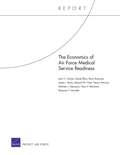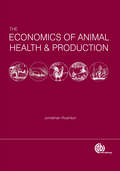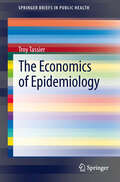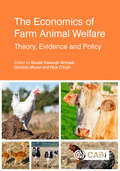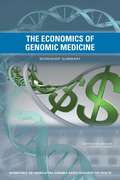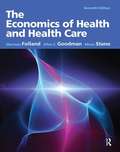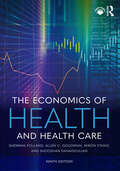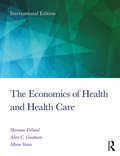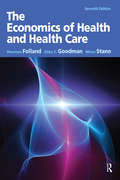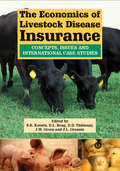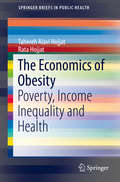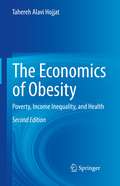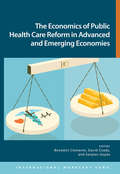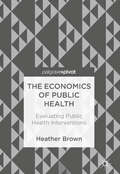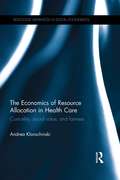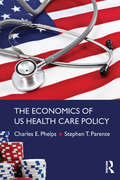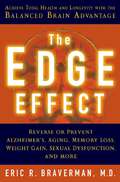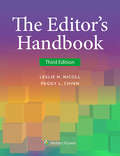- Table View
- List View
The Economic Evolution of American Health Care: From Marcus Welby to Managed Care
by David DranoveThe American health care industry has undergone such dizzying transformations since the 1960s that many patients have lost confidence in a system they find too impersonal and ineffectual. Is their distrust justified and can confidence be restored? David Dranove, a leading health care economist, tackles these and other key questions in the first major economic and historical investigation of the field. Focusing on the doctor-patient relationship, he begins with the era of the independently practicing physician--epitomized by Marcus Welby, the beloved father figure/doctor in the 1960s television show of the same name--who disappeared with the growth of managed care. Dranove guides consumers in understanding the rapid developments of the health care industry and offers timely policy recommendations for reforming managed care as well as advice for patients making health care decisions. The book covers everything from start-up troubles with the first managed care organizations to attempts at government regulation to the mergers and quality control issues facing MCOs today. It also reflects on how difficult it is for patients to shop for medical care. Up until the 1970s, patients looked to autonomous physicians for recommendations on procedures and hospitals--a process that relied more on the patient's trust of the physician than on facts, and resulted in skyrocketing medical costs. Newly emerging MCOs have tried to solve the shopping problem by tracking the performance of care providers while obtaining discounts for their clients. Many observers accuse MCOs of caring more about cost than quality, and argue for government regulation. Dranove, however, believes that market forces can eventually achieve quality care and cost control. But first, MCOs must improve their ways of measuring provider performance, medical records must be made more complete and accessible (a task that need not compromise patient confidentiality), and patients must be willing to seek and act on information about the best care available. Dranove argues that patients can regain confidence in the medical system, and even come to trust MCOs, but they will need to rely on both their individual doctors and their own consumer awareness.
The Economics of Addictive Behaviours Volume I
by John JoshuaThis title discusses the phenomenon of smoking as a behavioural disease and the associated costs. The author details the consequences of smoking, in addition to the detrimental effects caused by second-hand tobacco smoke exposure as a health risk to children as well as to the general public. The central contribution of Joshua's work is to address these concerns in terms of the issues of free choice and the market. Considering the various restrictive policies designed to reduce smoking's prevalence, including the banning of smoking in public places, and the inclusion of warning labels on cigarette packets, Joshua carefully analyses potential economic remedies to the problem of smoking, notably the Pigovian tax. Finally, the book concludes with a highly relevant discussion of corporate social responsibility, and the role that this might play in anti-smoking projects. This is the first title in a four volume series 'The Economics of Addictive Behaviours', which consists of three further volumes on alcohol abuse, illicit drug abuse and overeating.
The Economics of Addictive Behaviours Volume II
by John JoshuaThis title discusses the phenomenon of alcohol abuse as a behavioural disease and the associated costs. The author details alcohol's status as a psychoactive drug; he notes, however, that in contrast to other psychoactive drugs, alcohol has been widely culturally accepted in Western countries and legally available, except in isolated incidents for a short period of time. Joshua considers which policies are being correctly utilised so as to reduce the abuse of alcohol, and how these policies may operate on a supply and demand model. Whereas programs of prevention and treatment operate on the demand side of alcohol abuse, legislation is directed at the supply side of alcohol; that is, dealing with marketing - product, promotion, point of sales and price. This is the second title in a four volume series 'The Economics of Addictive Behaviours', consisting of three additional volumes on smoking, illicit drug abuse and overeating.
The Economics of Addictive Behaviours Volume III
by John JoshuaThis title offers an in-depth analysis of the causes, consequences and treatments of illicit drug abuse. The author examines the effects of existing drug policies and proposes drug use legalisation within a regulated market as a viable alternative. Joshua assesses the factors that make individuals vulnerable to drug abuse and the pathways they may follow. As well as exploring the physical and psychological effects on the individual, Joshua examines the social and economic consequences for society. He highlights the pitfalls of a purely legal approach to drug abuse, which is primarily a health matter, and questions whether special drugs courts could be used as an alternative to the present criminal justice system. This book adds to the debate on whether most drugs could be sold in a regulated market in the same way as other drugs are, such as alcohol or nicotine. This is the third title in a four volume series 'The Economics of Addictive Behaviours', consisting of three additional volumes on smoking, alcohol abuse and overeating.
The Economics of Air Force Medical Service Readiness
by Daniel Blum James J. Burks Edward W. Chan John C. Graser Kevin BrancatoThe Air Force Medical Service (AFMS) currently runs three in-theater hospitals for severely injured or wounded personnel. Part of the practioners' preparation was treating DoD beneficiaries for a broad range of injuries and illnesses. Opportunities for this preparation are not as numerous "in house" as they once were, and AFMS does not always get proper credit for those gained elsewhere. Proper credit for that work is important for funding.
The Economics of Animal Health and Production
by Jonathan RushtonThis book draws on both extensive literature and experience in animal health economics and livestock issues in Europe, Asia, Africa and Latin America. It provides comprehensive coverage of the history of livestock and animal health economics, theory and tools for the economics of animal health and production, a review of the application of economics to animal diseases and health problems, and worldwide examples of economic analysis and policy making.
The Economics of Epidemiology
by Troy TassierThe book presents a basic introduction to epidemiology from the perspective of economics, using economic modeling to better understand and describe how infectious disease spreads. Three main elements are introduced: epidemiology, social network analysis, and the economics needed to model the behavior of individuals in the presence of infectious disease. The book aims to provide a starting point for discussion between medical professionals, social scientists and public health officials, the three groups interested in the spread of disease.
The Economics of Farm Animal Welfare: Theory, Evidence and Policy
by Richard Bennett David Harvey Beth Clark Donald Broom Anne-Marie Neeteson Bettina Bock César Revoredo-Giha Alistair Lawrence Faical Akaichi Jean-Luc Angot Dr Santiago Avendaño Carmen Hubbard Alfons Koerhuis Carolina Maciel Jarkko K Niemi Alistair Stott Belinda VigorsThis landmark new text charts the latest developments in economic research relevant to farm animal welfare. A range of global experts and key opinion leaders outline the challenges in achieving sustainable livestock production while improving farm profit, climate change and animal welfare, and make policy-relevant recommendations for the future. This is a theoretical yet practical book that examines: - the origins of farm animal welfare, cross-disciplinary interactions and the future of the field; - consumer demand and changing preferences as animal welfare rises up the social agenda; - the impact political organisations such as the EU and WTO have on animal welfare. An important resource for policy makers and animal welfare scientists, economists and clinicians, this book provides a thought-provoking yet evidence-based review for all those interested in quantifying and improving farm animal welfare.
The Economics of Genomic Medicine
by Institute of Medicine Steve Olson Board on Health Sciences Policy Adam C. Berger Roundtable on Translating Genomic-Based Research for HealthThe sequencing of the human genome and the identification of links between specific genetic variants and diseases have led to tremendous excitement over the potential of genomics to direct patient treatment toward more effective or less harmful interventions. Still, the use of whole genome sequencing challenges the traditional model of medical care where a test is ordered only when there is a clear indication for its use and a path for downstream clinical action is known. This has created a tension between experts who contend that using this information is premature and those who believe that having such information will empower health care providers and patients to make proactive decisions regarding lifestyle and treatment options. In addition, some stakeholders are concerned that genomic technologies will add costs to the health care system without providing commensurate benefits, and others think that health care costs could be reduced by identifying unnecessary or ineffective treatments. Economic models are frequently used to anticipate the costs and benefits of new health care technologies, policies, and regulations. Economic studies also have been used to examine much more specific issues, such as comparing the outcomes and cost effectiveness of two different drug treatments for the same condition. These kinds of analyses offer more than just predictions of future health care costs. They provide information that is valuable when implementing and using new technologies. Unfortunately, however, these economic assessments are often limited by a lack of data on which to base the examination. This particularly affects health economics, which includes many factors for which current methods are inadequate for assessing, such as personal utility, social utility, and patient preference. To understand better the health economic issues that may arise in the course of integrating genomic data into health care, the Roundtable on Translating Genomic-Based Research for Health hosted a workshop in Washington, DC, on July 17-18, 2012, that brought together economists, regulators, payers, biomedical researchers, patients, providers, and other stakeholders to discuss the many factors that may influence this implementation. The workshop was one of a series that the roundtable has held on this topic, but it was the first focused specifically on economic issues. The Economics of Genomic Medicine summarizes this workshop.
The Economics of Health Reconsidered (Third Edition)
by Lynn Unruh Thomas RiceThis book reconsiders the field of health economics as it is traditionally taught and practiced. It critically examines economic theory as applied to the health sector and questions the prevailing belief that a competitive healthcare marketplace results in the best outcomes. New information, including an overview of standard microeconomic theory, makes this new edition an ideal stand-alone text for health economics and health policy courses.
The Economics of Health and Health Care (Seventh Edition)
by Sherman Folland Allen C. Goodman Miron StanoA text that covers core economic themes as they relate to health care.
The Economics of Health and Health Care: International Student Edition, 8th Edition
by Sherman Folland Allen C. Goodman Miron Stano Shooshan DanagoulianThe Economics of Health and Health Care is the market-leading health economics textbook, providing comprehensive coverage of all the key topics, and balancing economic theory, empirical evidence, and public policy. The ninth edition offers updated material throughout, including two new chapters: Disparities in Health and Health Care (Chapter 7) examines issues of race, ethnicity, income, gender, and geography with respect to health care access, health inputs, and health outcomes; Pandemic Economics (Chapter 9) introduces a new and simplified economic treatment of epidemics and pandemics within the context of COVID-19. We also include applications from the growing literature on digital medicine. The book further highlights the impacts of the Affordable Care Act (ACA) and updates its path-breaking comparative analyses across countries to focus on the differences in access and costs. The book continues to provide a clear, step-by-step understanding of health economics, making economic principles accessible to students, supported by boxed examples, figures and tables. Each chapter contains concise summaries, discussion questions, and quantitative exercises to promote student learning. There is also a glossary of key terms and an extensive reference list. Instructors are supported by a range of digital supplements. It is the perfect textbook for students and practitioners taking undergraduate and postgraduate courses in health economics, health policy, and public health.
The Economics of Health and Health Care: International Student Edition, 8th Edition
by Sherman Folland Miron Stano Allen Charles GoodmanFolland, Goodman, and Stano’s bestselling The Economics of Health and Health Care text offers the market-leading overview of all aspects of Health Economics, teaching through core economic themes, rather than concepts unique to the health care economy. The Eighth Edition of this key textbook has been revised and updated throughout, and reflects changes since the implementation of the Affordable Care Act (ACA). In addition to its revised treatment of health insurance, the text also introduces the key literature on social capital as it applies to individual and public health, as well as looking at public health initiatives relating to population health and economic equity, and comparing numerous policies across Western countries, China, and the developing world. It provides up-to-date discussions on current issues, as well as a comprehensive bibliography with over 1,100 references. Extra material and teaching resources are now also available through the brand new companion website, which provides full sets of discussion questions, exercises, presentation slides, and a test bank. This book demonstrates the multiplicity of ways in which economists analyze the health care system, and is suitable for courses in Health Economics, Health Policy/Systems, or Public Health, taken by health services students or practitioners.
The Economics of Health and Health Care: Pearson New International Edition
by Sherman Folland Miron Stano Allen Charles GoodmanFor courses in Health Economics, U.S. Health Policy/Systems, or Public Health, taken by health services students or practitioners, the text makes economic concepts the backbone of its health care coverage. Folland, Goodman and Stano's book is the bestselling Health Care Economics text that teaches through core economic themes, rather than concepts unique to the health care economy. This edition contains revised and updated data tables, where applicable. The advent of the Patient Protection and Affordable Care Act (PPACA) in 2010 has also led to changes in many chapters , most notably in the organization and focus of Chapter 16.
The Economics of Livestock Disease Insurance: Concepts, Issues and International Case Studies
by Stephen R. Koontz J. L. Grannis D. L. Hoag D. D. Thilmany J. W. GreeneThe collection of studies emerged from two conferences. One in Fort Collins, Colorado in November 2002 invited professionals from countries where livestock disease insurance is common to share their experience on the matter with American insurance professionals. The other, in July 2003 in Denver, focused primarily on the US. The information is intended to be useful primarily to government agents, the insurance industry, and academics in agricultural economics. The 20 papers explore how to build a livestock insurance program, look at the international marketplace, and present case studies. Annotation ©2006 Book News, Inc., Portland, OR (book news. com)
The Economics of Obesity
by Tahereh Alavi Hojjat Rata HojjatProviding a fascinating insight into the factors that influence individual choices regarding eating habits, diet and other behavioral patterns relevant to obesity, this book offers a new perspective about the relationship of obesity to poverty and inequality. The authors explore a unique socioeconomic model that helps build the framework to understand the causes of obesity and its relation to health, science, and economics. An essential read for policy makers who are seeking a framework to address this problem.
The Economics of Obesity: Poverty, Income Inequality, and Health
by Tahereh Alavi HojjatMuch has been written about the economic causes of obesity, but this book offers a comprehensive and deep investigation of the causes and treatment of these issues in a single volume. In the second edition, the author expands upon the serious threat that obesity poses not only to our health, but also to our society. Obesity costs billions of dollars a year in lost productivity and medical expenses. The social distribution of obesity has changed over time. Obesity rates in the United States continue to worsen in parallel with income inequality. Socioeconomic groups with low personal capital, levels of education, and income have higher obesity rates. In fact, the rate of obesity has increased the fastest among low-income Americans. The disproportionate burden of obesity on the poor poses an economic challenge and an ethical imperative. The link between obesity, inactivity, and poverty may be too costly to ignore because obesity-associated chronic disease already accounts for 70% of US healthcare costs. Although economic and technological changes in the environment drove the obesity epidemic, the evidence for effective economic policies to prevent obesity remains limited.The new edition brings together a multitude of topics on obesity previously not discussed with a particular emphasis on the influence of poverty and income inequality on obesity including:Economic Analysis: Behavioral Patterns, Diet Choice, and the Role of Government Income and Wealth Inequality and Obesity Social Mobility and HealthFood Policies, Government Interventions, and Reducing Poverty The Economics of Obesity is an essential text for readers interested in learning about the causes and consequences of obesity within a social context including students, academicians, and practitioners in public health, medicine, social sciences, and health economics, both in and outside of the United States. US and international policy-makers also will find the book a salient read in addressing the issues that contribute to the cycle of poverty, income inequality, and obesity.
The Economics of Public Health Care Reform in Advanced and Emerging Economies
by Sanjeev Gupta Benedict Clements David CoadyA report from the International Monetary Fund.
The Economics of Public Health: Evaluating Public Health Interventions
by Heather BrownNon-communicable diseases have surpassed infectious diseases as the leading cause of morbidity and mortality in developed countries. Prevention and treatment of the causes and consequences of lifestyle-related diseases forms an important part of health policy in the twenty-first century. Public health economics – from quantifying the problem, to evaluating interventions and developing toolkits to assist decision makers – is an essential area for any postgraduate student and researcher with an interest in applied economics to understand. There are a wide range of techniques from mainstream economics and health economics that can be applied to the evaluation of public health policy and public health issues. In this book, Brown presents examples from developed countries to illustrate how economic tools can be applied to public health. Further, cross-country comparisons illustrate how contextual factors related to healthcare systems, demographics and environmental factors may impact on outcomes and the cost-effectiveness of public health policies, in order to aid understanding and help students apply theory into practice.
The Economics of Resource Allocation in Health Care: Cost-utility, social value, and fairness (Routledge Advances in Social Economics)
by Andrea KlonschinskiThe question of how to allocate scarce medical resources has become an important public policy issue in recent decades. Cost-utility analysis is the most commonly used method for determining the allocation of these resources, but this book counters the argument that overcoming its inherent imbalances is simply a question of implementing methodological changes. The Economics of Resource Allocation in Health Care represents the first comprehensive analysis of equity weighting in health care resource allocation that offers a fundamental critique of its basic framework. It offers a critique of health economics, putting the discourse on economic evaluation into its broader socio-political context. Such an approach broadens the debate on fairness in health economics and ties it in with deeper-rooted problems in moral philosophy. Ultimately, this interdisciplinary study calls for the adoption of a fundamentally different paradigm to address the distribution of scarce medical resources. This book will be of interest to policy makers, health care professionals, and post-graduate students looking to broaden their understanding of the economics of the health care system.
The Economics of US Health Care Policy
by Charles E. Phelps Stephen T. ParenteIn this book, Phelps and Parente explore the US health care system and set out the case for its reform. They trace the foundations of today’s system, and show how distortions in the incentives facing participants in the health care market could be corrected in order to achieve lower costs, a higher quality of care, a higher level of patient safety, and a more efficient allocation of health care resources. Phelps and Parente propose novel yet economically robust changes to US tax law affecting health insurance coverage and related issues. They also discuss a series of specific improvements to Medicare and Medicaid, and assess potential innovations that affect all of health care, including chronic disease management, fraud and abuse detection, information technology, and other key issues. The Economics of US Health Care Policy will be illuminating reading for anyone with an interest in health policy, and will be a valuable supplementary text for courses in health economics and health policy, including for students without advanced training in economics.
The Ecotoxicology of Aquatic Macrophytes (Environmental Contamination Remediation and Management)
by Chris D. Metcalfe Mirta L. MenoneThis book focuses on the topic of ecotoxicology of aquatic macrophytes and is wide ranging, including the use of macrophytes for remediation of contaminated sites. Many human activities are threats to the equilibrium of natural ecosystems. Pollution from point and non-point sources can be assessed using a variety of techniques, such as biomonitoring, biomarkers and biosensors. In aquatic ecosystems, biomonitoring of pollutants is mostly conducted by analysis of the tissues of invertebrates and fishes, and biomarker studies are also more widely applied to animals rather than in plants. Aquatic macrophytes occupy a key niche in aquatic ecosystems and provide a range of ecosystem services. In addition to their role in primary production, vegetation plays a key role in the cycling and retention of nutrients and generally acts as a sink for pollutants. Therefore, because of their importance to aquatic ecosystems, more attention should be paid to understanding the fate of pollutants and to developing methods to evaluate the health status of macrophytic plants in freshwater, marine and estuarine environments.
The Edge Effect: Achieve Total Health and Longevity with the Balanced Brain Advantage
by Eric R. BravermanA proven program to reverse and prevent aging that will be a must-have for all “baby boomers,” by a leading figure in the medical field and a frequent guest on national TV.This could be as close to a fountain of youth as mankind will ever come, the truly scientific answer to how to reverse or prevent the debilitating effects of aging, including memory loss, weight gain, sexual dysfunction, and Alzheimer’s.Dr. Eric Braverman, a leading figure in the practice of brain-body health care, reveals the dramatic impact that proper brain nourishment can have on the quality of our lives. His key to longevity and well-being is balancing the brain’s four important neurotransmitters. A simple test determines which of the four is dominant in you, and what you can do to maintain the right balance, by modifying your diet with both foods and natural supplements. Proven effective for thousands of patients in Dr. Braverman’s practice, this groundbreaking approach will help anyone make the most of his or her life, free of the major illnesses (such as cancer and heart disease) and minor ailments as well.
The Edinburgh Seven: The Story of the First Women to Study Medicine
by Janey JonesWomen have healed since the beginning of time, but accessing a formal degree in medicine was impossible for them in Britain until the late 19th century. In 1869, a group of women began arriving in Edinburgh to study at the medical faculty, led by the indomitable Sophia Jex Blake. They would eventually be known around the world as The Edinburgh Seven. They were delighted to become students of medicine and as Sophia said, they simply wanted 'a fair field and no favour'. But some of the traditional professors at the university did not approve of women becoming practicing doctors. The medical women would soon discover that they were welcome as hobbyists but not as competitors with male students. There were legal wrangles, court cases, personal attacks and even a full blown riot - all because some male medics wanted rid of the women. And the women did leave Edinburgh - without degrees. But they finished their studies in mainland Europe and came back as fully fledged doctors. In 2019, the University of Edinburgh awarded the Seven their degrees posthumously via current day medical students. At last, the right thing was done, but the struggles of the original Seven should never be forgotten. This is their story.
The Editor's Handbook
by Leslie H. Nicoll Peggy L. ChinnThe completely updated 3rd edition of The Editor’s Handbook is an invaluable resource to all those involved in various aspects of scholarly writing in nursing. Both novice and experienced editors will no doubt find the information quite useful, as they did the first two editions. Although the main focus of the handbook is on the editors of nursing journals, all types of nurse writers will appreciate the extensive details and helpful tips. Nurses who are in the process of preparing manuscripts for publication can use the handbook to enhance their success at journal acceptance by getting a unique view of the editor’s role and perspective.
